
Rainbow Trout
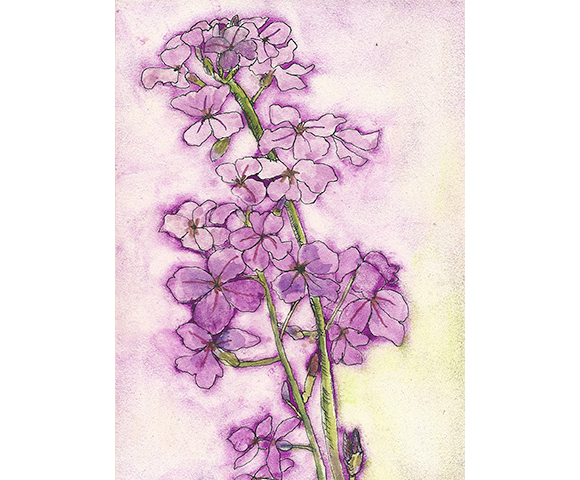
Dame’s Rocket
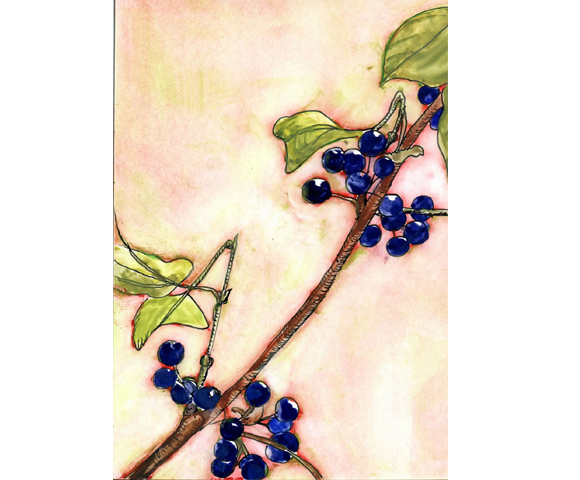
Buckthorn
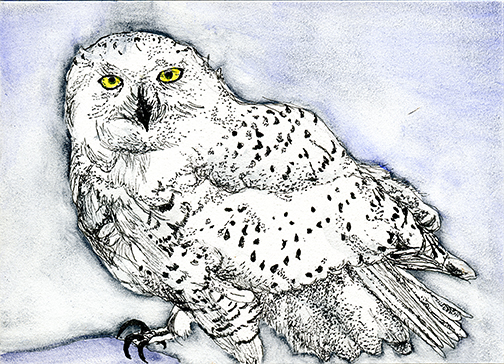
Snowy Owl

Bullfrog

Flowering Rush
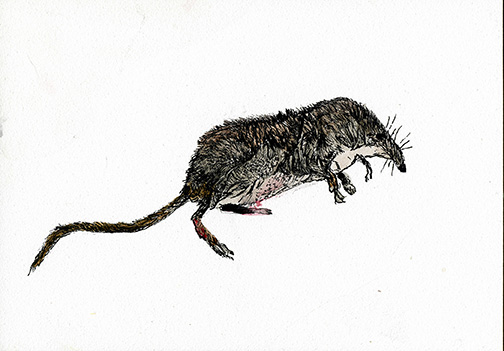
Masked Shrew
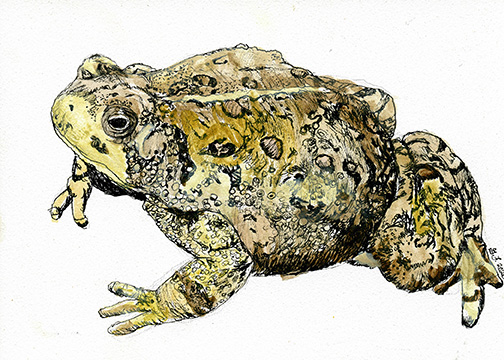
American Toad

American Eel
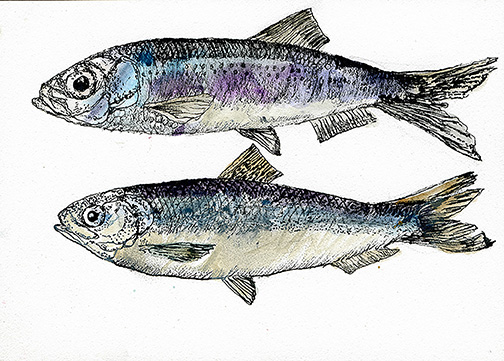
Eighty-Six Fish!

©? Gwen Frankton, Rainbow Trout
OK, let’s see if I get this because it is rather complicated. The rainbow trout (oncorhynchus mykiss) is actually native to the Pacific basin. BUT it has been introduced elsewhere since 1875, often for sports fishing and is now all over the place. And where they have been introduced they have done no good to native species. Consequently the rainbow trout is included in the list of 100 globally invasive species.
The steelhead trout is actually an anadromous (and that means sea-going) form of the coastal rainbow trout. The freshwater forms that have been introduced into the Great Lakes migrate into tributaries to spawn and THEY are also called steelhead. Can that be right? Further research is required.
So the freshwater river going guys are smaller between .5-2.3 kg but lake dwelling and sea-going ones can be as big as 9kg.
The freshwater ones, as we might find in the Ottawa river, usually spawn where there is a bed of fine gravel. The female lays 2000-3000 eggs , which fall into spaces between the gravel. Meanwhile the male is swimming along behind, fertilizing the eggs. The female immediately covers them with gravel. They take 4-7 weeks to hatch. They live to be about 10-11 years.
And they really are beautiful, especially the breeding males with their reddish- pink stripe along the lateral line.

©?Gwen Frankton, Dames Rocket
Dame’s Rocket (Hesperus Matronalis) is a non-native, short lived perennial. It is very common, grows all over the place, is beautiful and smells nice, most strongly in the evening, what’s not to love? Well, it does grow as a weed in our Maitland, NS garden and it’s hard to make a concentrated effort to get rid of it.
It has knobby, horizontal rhizomes that are not fragile and are not that easy to pull up. The flowers are pink, white or purple, have four petals and six yellow stamens.
Dame’s Rocket forms colonies in meadows and grows under hardwoods, but not conifers. You see it along fences, in ditches - everywhere. It arrived in North America in the 1600s.

©?Gwen Frankton, Common Buckthorn
Common Buckthorn is a highly invasive species with simple, alternate leaves and black or red berry- like drupes. It has a woody spine at the end of each twig, hence the name. It spreads so well because it is a super efficient grower that doesn’t need much sunlight and is very fertile. The seeds are very hardy and grow and spread in a variety of conditions. And animals do not like to eat the fruit, which may even make them sick.
Not only is buckthorn highly invasive- you see it all over the place - but it is also a host for the soybean aphid AND an oat fungus. Honestly, it doesn’t have much to recommend it! The berries do, however, contain a yellow dye and make a beautiful sap-green ink.

©?GwenFrankton, Snowy Owl, pen and ink and watercolour on aquabord
The snowy owl (Bubo scandiacus)is a large, white owl of the true owl family. It is the only owl that is entirely white (females are flecked with dark brown.) Unlike most owls it is active during the day. Breeding and the entire global population are closely tied to the availability of tundra dwelling lemmings. It can adapt to eating lots of other things but lemmings are of primary importance.
Snowy owls lay many eggs, usually in a nest on a small rise of ground or hummock on the tundra. They are nomadic, they don’t continue to breed at the same location or with the same mate and they wander all over the place. They are white, with bright yellow eyes. Their toes are thickly covered with white feathers and have black claws. They have excellent long range vision.
Although they are arctic birds they do migrate further south in winter and end up all over - southern Canada, Iceland, Ireland, Scotland etc.
Sometimes there are large winter irruptions, thought to be due to good breeding conditions in their home ranges. At such times they have been found as far south as Georgia, even California and Hawaii. Unusually, there was a mass migration in 2011 and 2012, when they were found all over Canada and the states.
Snowy owl’s existence is considered to be fragile, the population has dropped dramatically, possibly in response to global warming.

©Gwen Frankton, Bullfrog
Bullfrogs are large, true frogs. They are voracious, opportunistic ambush predators that prey on any small animal they can overpower and stuff down their throats (Wikipedia.) They can do this because of their powerful jaws and rapid tongue strike. They can make allowances for light refraction on the water and strike at just the right spot. Their means of hunting is unique. A bullfrog orients towards the prey and then makes a huge, rapid lunge, eyes closed. It opens its mouth like a slingshot, the mucous covered tongue extends towards it’s prey, often enveloping it while at the same time the wide open jaw is moving forward to bite at the exact moment the tongue is withdrawn. Wow! If the prey doesn’t fit they use their hands to stuff them in.
Males form groups called choruses. Together they make an impressive acoustical display that attracts females. These choruses form and reform and the position near the centre, and therefore dominance is important. Males fight and posture as the one illustrated is doing, showing his yellow throat. Older males have a more central position and breed through the season.
Females lay up to 20,000 eggs, which form a thin, floating sheet. Eggs hatch in 3-5 days. Young tadpoles live in shallow water, moving to deeper water , as they grow. In the North, where waters are cooler than, say Florida, they make take a much as three years to reach maturity, where it would happen in a couple of months in warmer water.

The flowering rush (butomus umbellatus) is not actually a rush at all. It is very beautiful but it has become a serious invasive weed in the Great Lakes. I don’t know if it is considered to be an invasive weed in this area but I intend to find out because I know where there are two stands locally. One is in a little creek that runs into Graham Creek in Andrew Hayden park and the other is on a marshy part of the shore near the NCC trail.
It grows in still and slowly moving water to a depth of three metres. It has linear, pointed leaves that are about a metre long, they grow in two rows from the rhizome base. The inflorescence is umbel like (like an upside down umbrella) and each little flower has three pink petals with darker veins. They flower from July to August.

©?Gwen Frankton, Masked Shrew, ink and watercolour on aquaboard
The masked shrew (sores cinereus) is the most widely distributed shrew in North America. It is very small with a pointed snout, grey brown fur and a light grey underside. Apparently a masked shrew’s body size is less if it lives where it is colder - and they live all over the place. Moisture is a determinant of shrew abundance but otherwise they inhabit grasslands, marshes and tundra.
Masked shrews are opportunistic generalists. That means they will eat almost anything - insects, seeds, small rodents, small amphibians, worms and snails. They have a very high metabolism and can survive only a few hours without food. They can eat three times their body weight in one day and are very susceptible to parasites like fleas and tapeworms, particularly because they eat so much. They are also food for many predators; hawks, owls, shrikes,snakes, herons, foxes, leopard frogs, bluebirds, brown trouts and weasels.
Shrews dig tunnels and use those made by other animals, making nests of dry grass in those tunnels. They are born in spring and summer, grow to adulthood over the winter and are ready to breed in the spring. They often don’t live for more than a year.
Masked shrews are not at all fond of other masked shrews.

©Gwen Frankton, American Toad, pen and watercolour on aquaboard
The mating call of the male American Toad (anaxyrus Americans), in spring, is a high, trilling sound, like a telephone ringing. The female lays its eggs in two long strings that hatch in 2-14 days. The tadpoles are small, black and have skinny tails. They hide in shallow water with thick vegetation and are protected from predators by a noxious chemical secreted in their skin.
The little toadlets stay in the water for a while but then they migrate, en masse, to shady forest areas nearby. You might find that the trail you are walking on is suddenly covered by tiny toads.
Toads eat bugs, ants, spiders, slugs and worms. They are creatures of habit- they like to stay where they are, ideally where there is cool shade and a proximity to water. When it starts to get cold they dig backwards, vigorously, covering themselves with leaf mould and soil and they hibernate for the winter months.

©?Gwen Frankton, American Eel, ink and watercolour on aquaboard
The American Eel River (Anguilla rostrata) has a long, slender snake-like body. It is covered with a mucous layer so it looks naked and slimy but it is actually covered with tiny scales. It has a long dorsal fin down the middle of its back and a similar ventral fin.
American Eels have a very interesting life history. They live in fresh water but leave to make the spawning migration to the Sargasso Sea! A female eel might live in freshwater for 10-25 years but then she migrates to the ocean to spawn, lays up to 4 million eggs and dies. The little hatchlings, called leptocephalli, are flat and transparent, they metamorphosize into glass eels next. It takes them years to get from the ocean to fresh water, where they became yellow eels and eventually reach adult form.
They are bottom dwellers, hunting at night for crustaceans, aquatic insects, and whatever aquatic organisms they can find and hiding during the day in mud, sand and gravel close to the shore.
They are found all along the St. Lawrence and related river systems where they were once abundant and were an important fishery for aboriginal people. However the construction of hydroelectric dams has blocked their migration and reduced their numbers dramatically. According to the Ottawa Riverkeeper 98% of the eel population has collapsed in the Ottawa River. The construction of eel ladders enables migrating eels to get past obstacles. There is one at the Chaudiere Dam in the Ottawa River and it hoped that there will eventually be more at other dams.
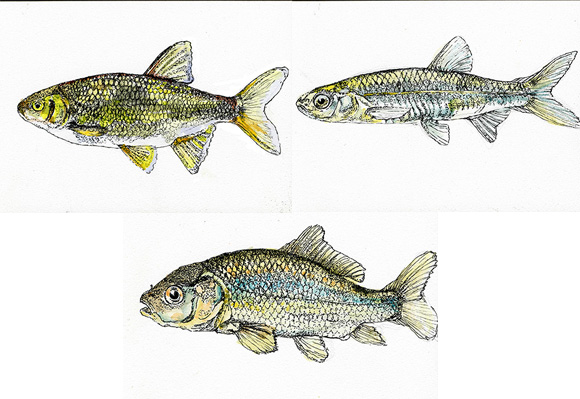
Golden shiner, emerald shiner, common carp
I learned from the Ottawa Riverkeeper website that there are 86 fish species in the Ottawa River. I was very surprised! And so is everybody I tell. I don’t know very much about fish- they are fishy mysteries! So I have decided to draw all 86 species. It will take me forever but I will learn a lot about fish. And maybe by the time I am done the pandemic will be over! So far I have done drawings of six fish so we will just have to see how it goes.